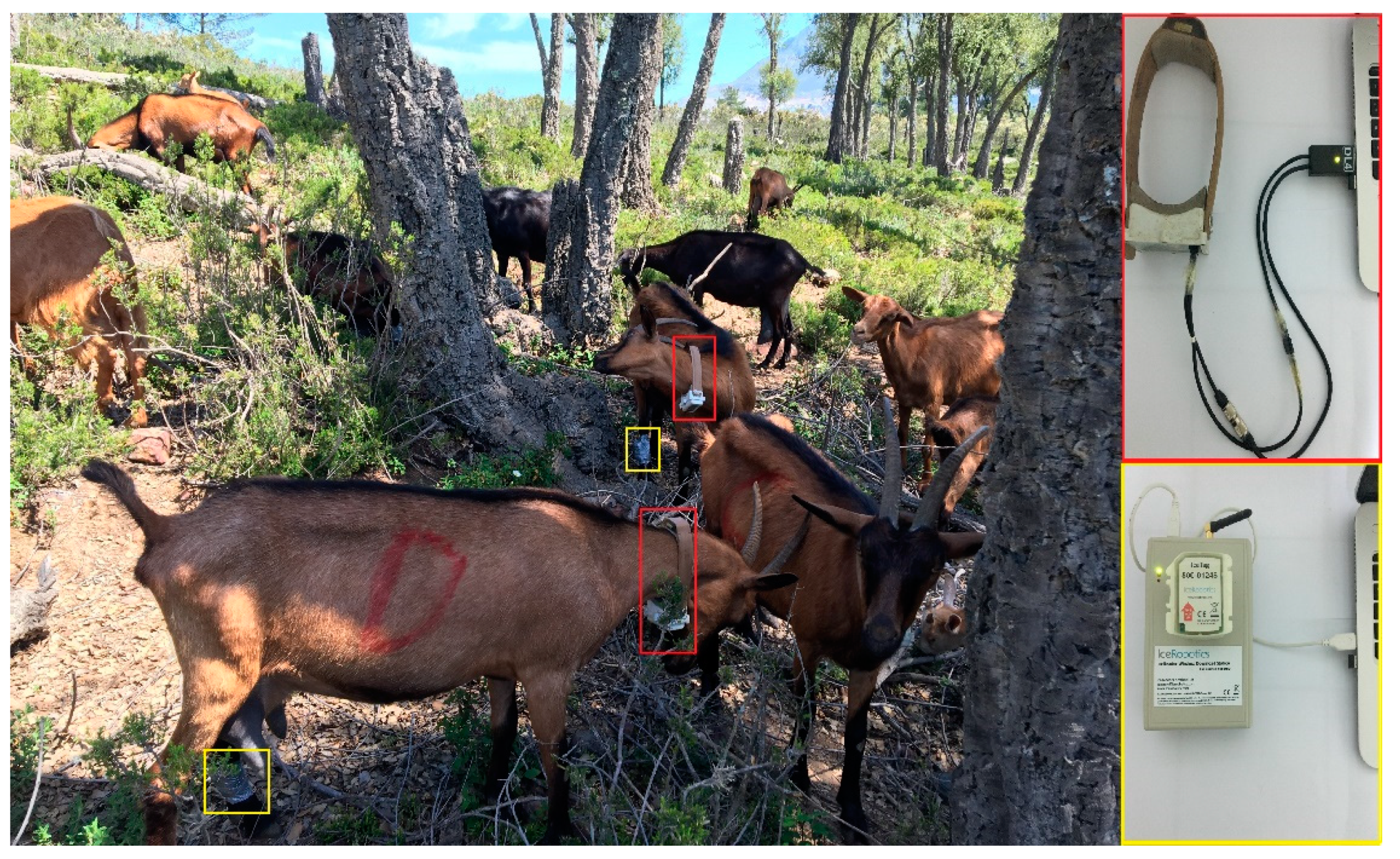Using GPS Tracking Collars and Sensors to Monitor the Grazing Activity of Browsing Goats in Forest Rangeland †
Abstract
1. Introduction
2. Materials and Methods
2.1. Study Area
2.2. Data Source
2.3. Data Analyses
3. Results and Discussion
4. Conclusions
Author Contributions
Funding
Institutional Review Board Statement
Informed Consent Statement
Data Availability Statement
Acknowledgments
Conflicts of Interest
References
- Chebli, Y.; Chentouf, M.; Ozer, P.; Hornick, J.L.; Cabaraux, J.F. Forest and silvopastoral cover changes and its drivers in northern Morocco. Appl. Geogr. 2018, 101, 23–35. [Google Scholar]
- Chebli, Y.; El Otmani, S.; Chentouf, M.; Hornick, J.L.; Bindelle, J.; Cabaraux, J.F. Foraging behavior of goats browsing in southern Mediterranean forest rangeland. Animals 2020, 10, 196. [Google Scholar] [CrossRef] [PubMed]
- Osuji, P.O. The physiology of eating and the energy expenditure of the ruminant at pasture. J. Range Manag. 1974, 27, 437–443. [Google Scholar] [CrossRef]
- Lachica, M.; Aguilera, J.F. Methods to estimate the energy expenditure of goats: From the lab to the field. Small Rumin. Res. 2008, 79, 179–182. [Google Scholar]
- Handcock, R.N.; Swain, D.L.; Bishop-Hurley, G.J.; Patison, K.P.; Wark, T.; Valencia, P.; Corke, P.; O’Neill, C.J. Monitoring animal behaviour and environmental interactions using wireless sensor networks, GPS collars and satellite remote sensing. Sensors 2009, 9, 3586–3603. [Google Scholar] [CrossRef] [PubMed]
- Hulbert, I.A.; Wyllie, J.T.; Waterhouse, A.; French, J.; McNulty, D. A note on the circadian rhythm and feeding behaviour of sheep fitted with a lightweight GPS collar. Appl. Anim. Behav. Sci. 1998, 60, 359–364. [Google Scholar]
- Beker, A.; Gipson, T.A.; Puchala, R.; Askar, A.R.; Tesfai, K.; Detweiler, G.D.; Asmare, A.; Goetsch, A.L. Energy expenditure and activity of different types of small ruminants grazing varying pastures in the summer. J. Appl. Anim. Res. 2010, 37, 1–14. [Google Scholar]
- Brassard, M.E.; Puchala, R.; Gipson, T.A.; Sahlu, T.; Goetsch, A.L. Factors influencing estimates of heat energy associated with activity by grazing meat goats. Livest. Sci. 2016, 193, 103–109. [Google Scholar]
- Safari, J.; Mushi, D.E.; Kifaro, G.C.; Mtenga, L.A.; Eik, L.O. Seasonal variation in chemical composition of native forages, grazing behaviour and some blood metabolites of Small East African goats in a semi-arid area of Tanzania. Anim. Feed Sci. Technol. 2011, 164, 62–70. [Google Scholar]
- Baumont, R.; Prache, S.; Meuret, M.; Morand-Fehr, P. How forage characteristics influence behavior and intake in small ruminants: Review. Livest. Prod. Sci. 2000, 64, 15–28. [Google Scholar] [CrossRef]
- Ferreira, L.M.M.; Celaya, R.; Benavides, R.; Jáuregui, B.M.; García, U.; Sofia Santos, A.; Rosa García, R.; Rodrigues, M.A.M.; Osoro, K. Foraging behaviour of domestic herbivore species grazing on heathlands associated with improved pasture areas. Livest. Sci. 2013, 155, 373–383. [Google Scholar]
- Chebli, Y.; El Otmani, S.; Hornick, J.-L.; Keli, A.; Bindelle, J.; Chentouf, M.; Cabaraux, J.-F. Using GPS collars and sensors to investigate the grazing behavior and energy balance of goats browsing in a Mediterranean forest rangeland. Sensors 2022, 22, 781. [Google Scholar] [CrossRef] [PubMed]
- Charnov, E.L. Optimal foraging: The marginal value theorem. Theor. Popul. Biol. 1976, 9, 129–136. [Google Scholar] [PubMed]



Publisher’s Note: MDPI stays neutral with regard to jurisdictional claims in published maps and institutional affiliations. |
© 2022 by the authors. Licensee MDPI, Basel, Switzerland. This article is an open access article distributed under the terms and conditions of the Creative Commons Attribution (CC BY) license (https://creativecommons.org/licenses/by/4.0/).
Share and Cite
Chebli, Y.; El Otmani, S.; Cabaraux, J.-F.; Keli, A.; Chentouf, M. Using GPS Tracking Collars and Sensors to Monitor the Grazing Activity of Browsing Goats in Forest Rangeland. Eng. Proc. 2022, 27, 37. https://doi.org/10.3390/ecsa-9-13331
Chebli Y, El Otmani S, Cabaraux J-F, Keli A, Chentouf M. Using GPS Tracking Collars and Sensors to Monitor the Grazing Activity of Browsing Goats in Forest Rangeland. Engineering Proceedings. 2022; 27(1):37. https://doi.org/10.3390/ecsa-9-13331
Chicago/Turabian StyleChebli, Youssef, Samira El Otmani, Jean-François Cabaraux, Abdelhafid Keli, and Mouad Chentouf. 2022. "Using GPS Tracking Collars and Sensors to Monitor the Grazing Activity of Browsing Goats in Forest Rangeland" Engineering Proceedings 27, no. 1: 37. https://doi.org/10.3390/ecsa-9-13331
APA StyleChebli, Y., El Otmani, S., Cabaraux, J.-F., Keli, A., & Chentouf, M. (2022). Using GPS Tracking Collars and Sensors to Monitor the Grazing Activity of Browsing Goats in Forest Rangeland. Engineering Proceedings, 27(1), 37. https://doi.org/10.3390/ecsa-9-13331






